Last November, I visited Japan and managed to attend an event called NEC EXPO.
Once a year, NEC holds an exhibition of achievements and shows them to its customers and partners.
The exhibition presents as new major products that are on the wave of the general mobilization of the company's forces. As, for example, now these are products for ensuring safe urban life, monitoring systems, analytical systems.
In addition, they show innovations in high technology, from concepts to finished products.
You can read more about the exhibition on the website, but alas,
everything is in Japanese .
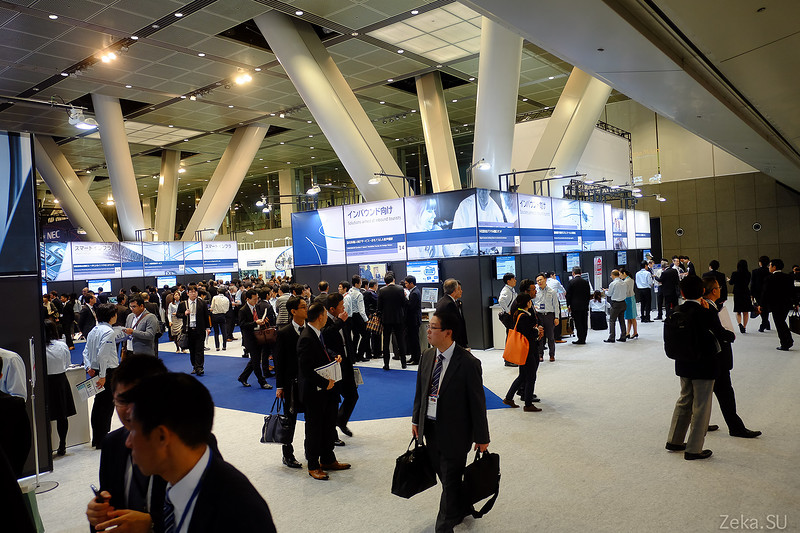
Why I want to tell you about this exhibition, well, probably because I was there the only Russian-speaking person with a camera and an understanding of at least some of what was shown there. The exhibition is more focused on the Japanese market, although some products are offered on the international market.
I will also say right away that I can’t answer most of your specialized questions: a) I am not an employee of NEC, b) I didn’t understand everything myself and this material could rather be attributed to the type of “Chukchi song” that he saw, then he sang. Plus, immediately consider that there was a language barrier problem. Not all stands were presented in English and not all managed to communicate at a decent level. Our general level of knowledge of English in the dialogues was sometimes below average. Therefore, part of the information was drawn from advertising booklets and materials on the company's website.
So, take what you see not as an advertisement for the company's products, but as a “look at walk”.
Let's go in order.
Security technology
NEC offers a product line for city security, crowd control systems, satellite imagery analysis systems.
The concept of safe city implies the following elements.
- Global Surveillance System
- Face recognition system and residents database
- Acoustic control systems
- Terrain monitoring systems with drones and satellites
- Analytical systems for recording changes in terrain on satellite images.
- Coordination center to ensure the interaction of the system and various services, police, public utilities, power
All elements of this system are offered by NEC for implementation.
The basis of all recognition systems is the
NEC the WISE platform.
An artificial intelligence platform used in a large number of products for recognition and analysis of BiG Data.
Different cameras are used in video surveillance systems, but only HD cameras are recommended for recognition systems.
Let's see how the system works.
The first step is to register in the system. Photo enough.

And then the system will analyze the video and find all your images on surveillance cameras. When and where was seen:
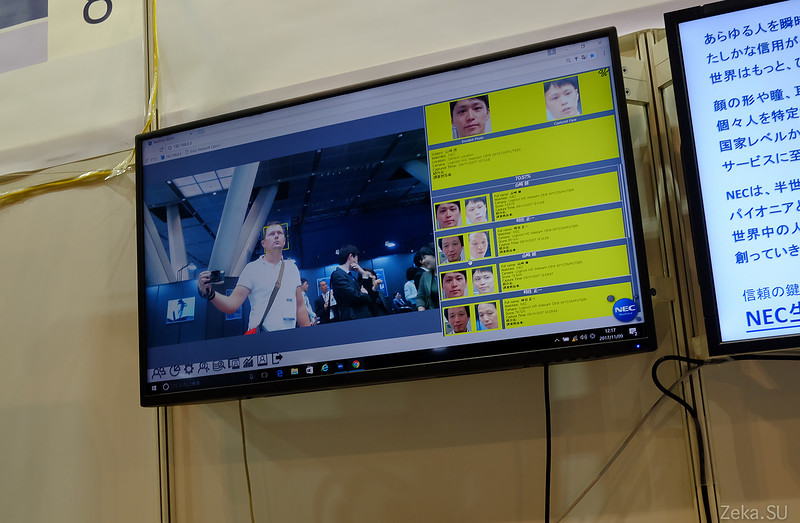
Naturally, working with large amounts of data, for example, within a city, requires appropriate hardware. Here is a dedicated processing server or individual accelerators for computing.

And then everything is like in the worst dreams of paranoids or in popular futuristic series.
Singapore has implemented and launched this system on the territory of the entire city. This reduced crime and ensure security.
The software will find you on any CCTV camera connected to the citywide security system.

This is how it looks for the dispatcher.
If you wish, you can sign each of his last name and everyone will be seen who is wanted, who has behaved badly.
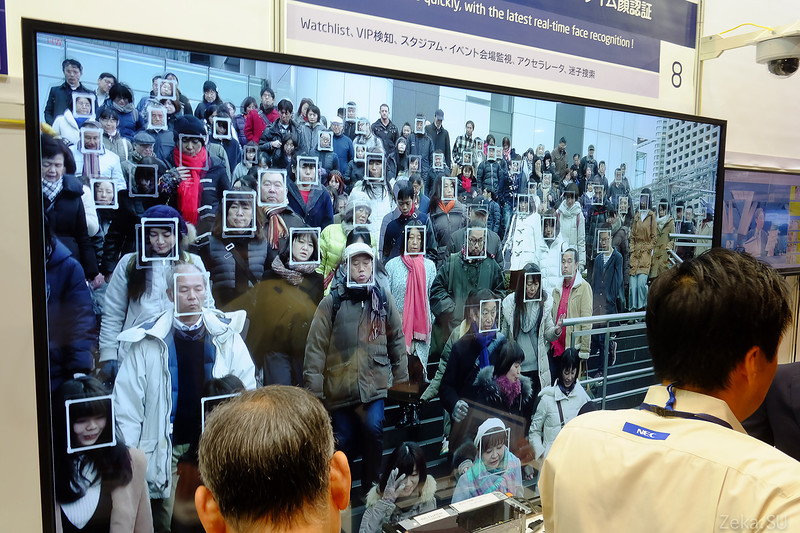
For security systems at stadiums or other similar facilities, the Crowd Managment Solution product is offered. CCTV and facial recognition. Control the number of people at entrances exits. Analysis of their movement. It can also automatically calculate problem areas. Where traffic jams, where conflicts.
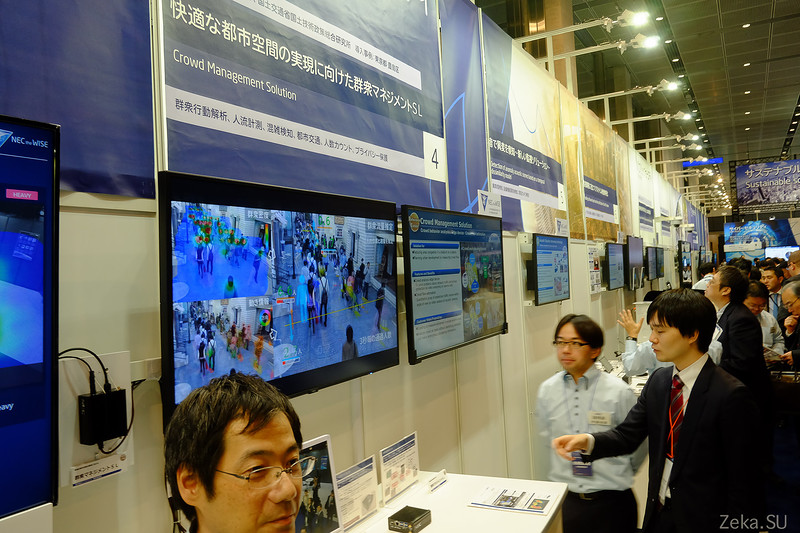
For convenience of monitoring, the use of mobile surveillance cameras is recommended.
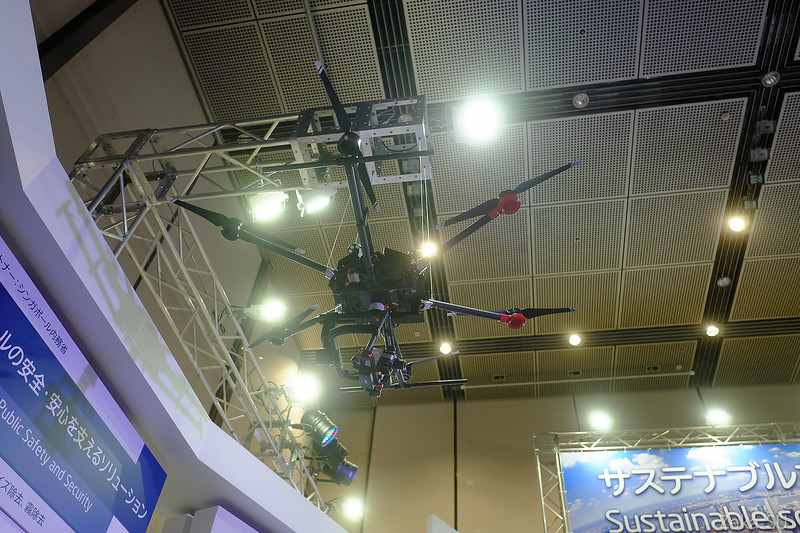
In addition, the system analyzes image changes from both cameras and satellites in order to find suspicious changes.
Here, for example, a bag was discovered that was not there before. Perhaps there is a danger.

Or here's an acoustic tracking system for the city. The system allows you to determine the source of noise from records from different places, and report it to the nearest group that can react. For example, the noise of a shot, shouts or, for example, an incomprehensible noise, which is usually not observed at this place (rallies are all illegal).
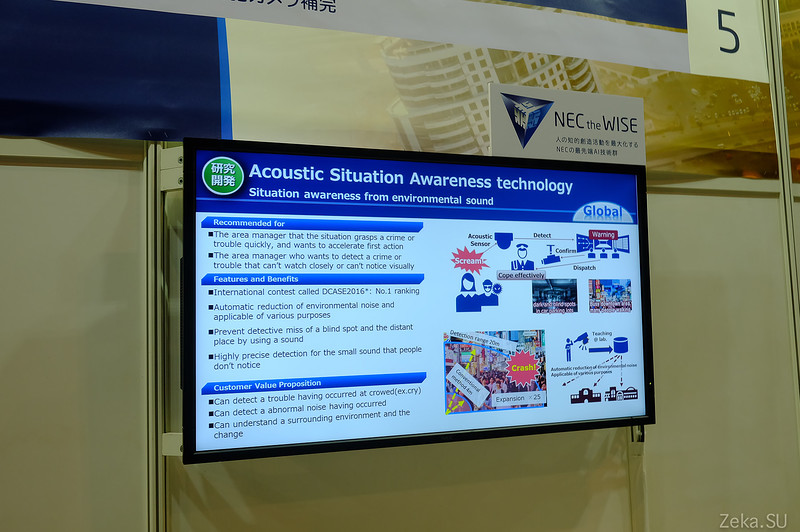
Eye recognition. Demonstration. You look at the flower and it turns off. I checked, works.
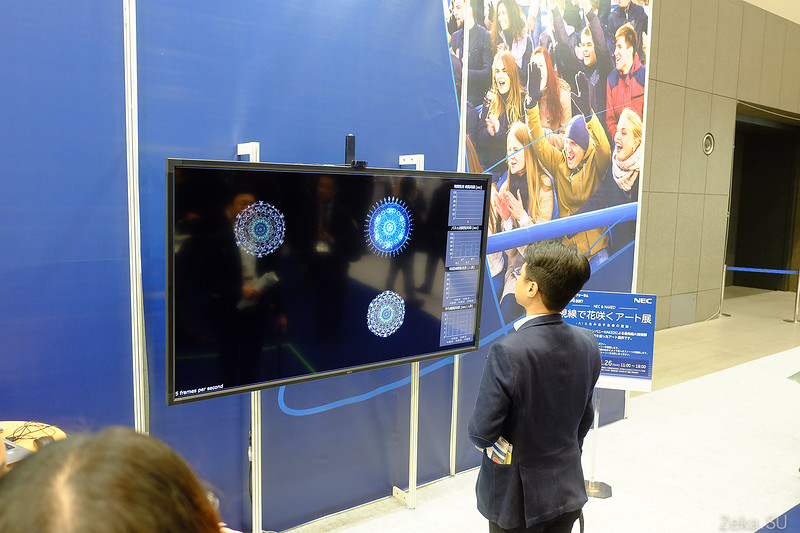
Planned use, monitoring systems and analysis of the behavior of people in the store, for example. You can use the camera to study the behavior of users in the storefront, which product attracts, which one they look at for a long time, or immediately look away.
Again, you can control something with a simple look.
Actually, it already works in face recognition systems. The visualization is amusing, everything is like on Japanese cartoons where robots are shooting lasers from their eyes =)
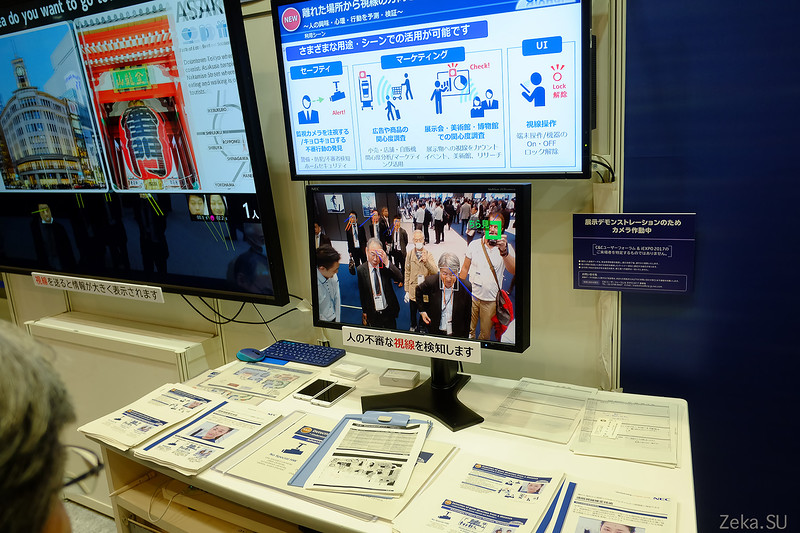
If desired, you can even define an aggressive look.

Biometric identification system on the iris. This camera takes pictures of your eyes and everything is ready.
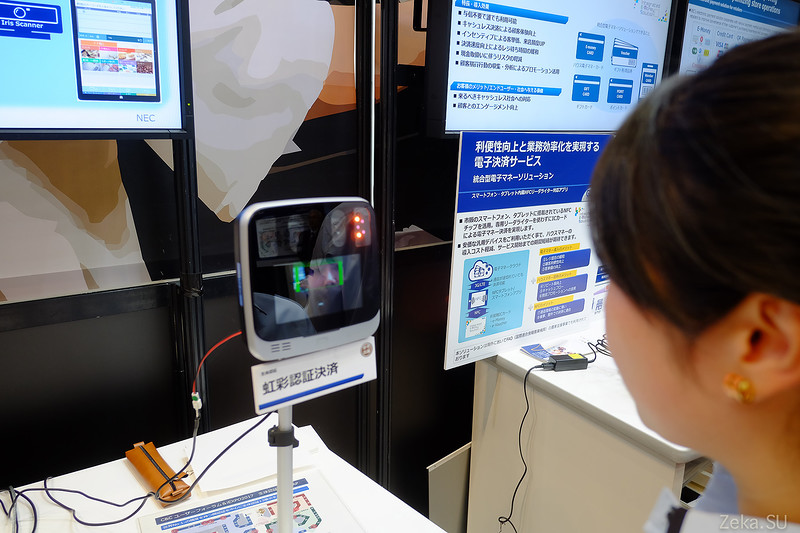
This system is offered for implementation in contactless payment systems in stores. It is more difficult to forge an iris than to deceive a face recognition system with a mask.
And this is a demonstrator system for consumers. A robot with face recognition, sight, voice recognition systems. Can communicate with you as an interested person. He recognizes you by his face, listens to you, answers. Perfect companion.

Almost all the products shown above are ready-made and working things.
A city-wide security system with thousands of cameras, sound analysis, monitoring from space and kopter is launched in Singapore.
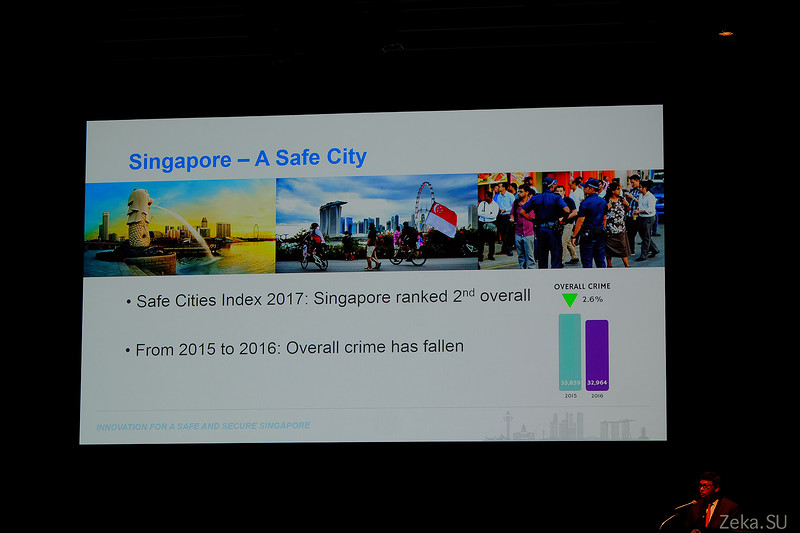
Here are the numbers:
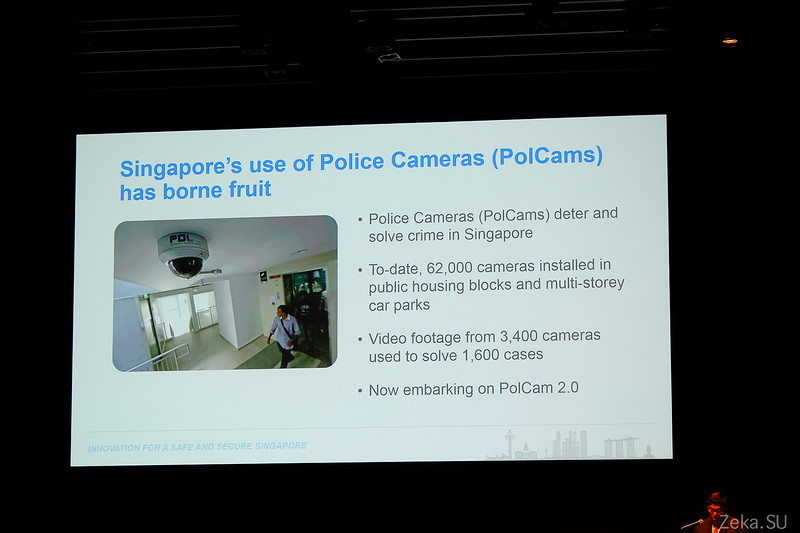
In addition, all data on accidents, crime problems are collected in a single BigData and analyzed to find and eliminate narrow and dangerous places.
Now let's move on from big things to smaller and more practical products.
Chameleon Barcode Chameleon Code Reader
A rather old technology actively promoted by NEC in its products.
It is offered as a more convenient replacement of RFID tags with colored stickers.
4 colors, two-dimensional array of squares, any scanner or camera and everything works. No special reading equipment is required. Mediocre enough color camera and computer or tablet.

The cost is several times lower than for RFID, since tags can be simply printed on the printer or displayed on the screen.
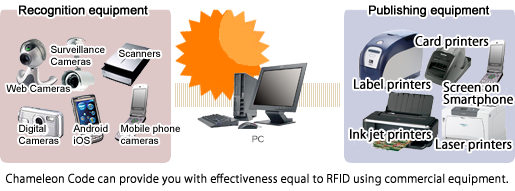
For example, you have a warehouse with hundreds of boxes on the rack. If you use a conventional barcode, you will need to attach a scanner to each, and here you can scan everything with a camera phone.
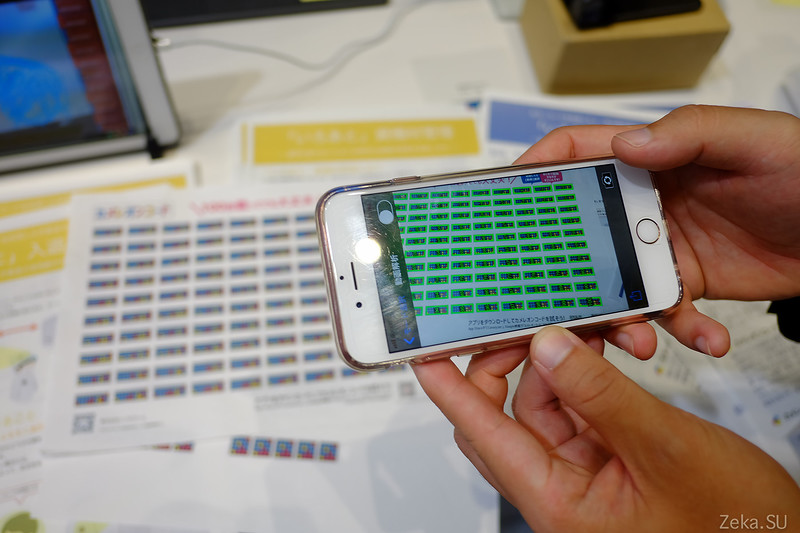
At the exhibition itself, all guests had badges with this code. I photographed a person with a badge and everything, you can check on the database who he is.
By the way, this is another application promoted for using this code. Caps for workers with codes and the usual video surveillance system, you can monitor the workers throughout the building.
Here is an example of surveillance:
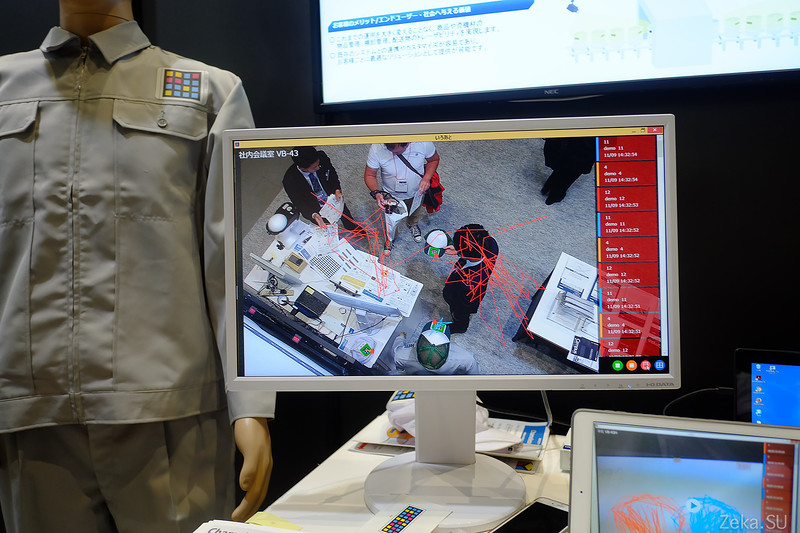
Supercomputers
I used to read about Japanese supercomputers on the Internet, but alas, not enough. And here you can touch them.
This red "video card" is a vector 8 processor supercomputer
SX-Aurora TSUBASA .
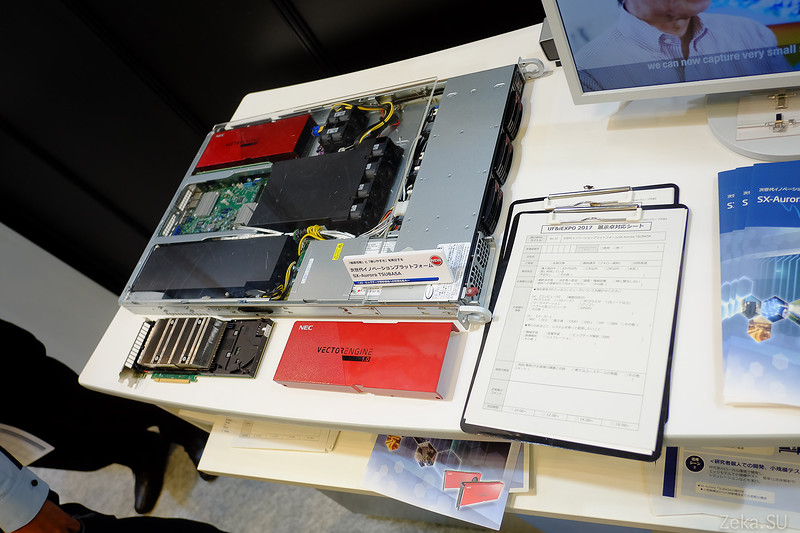
It goes into the usual PCIe slot and the calculations you require are run on it. Power of one module 2.45 TeraFLOPS.
As the host machine, the usual x86 server on Xeon running Linux is used, and from it the computation is started on vector processors.
You can buy as much as you need for capacity.
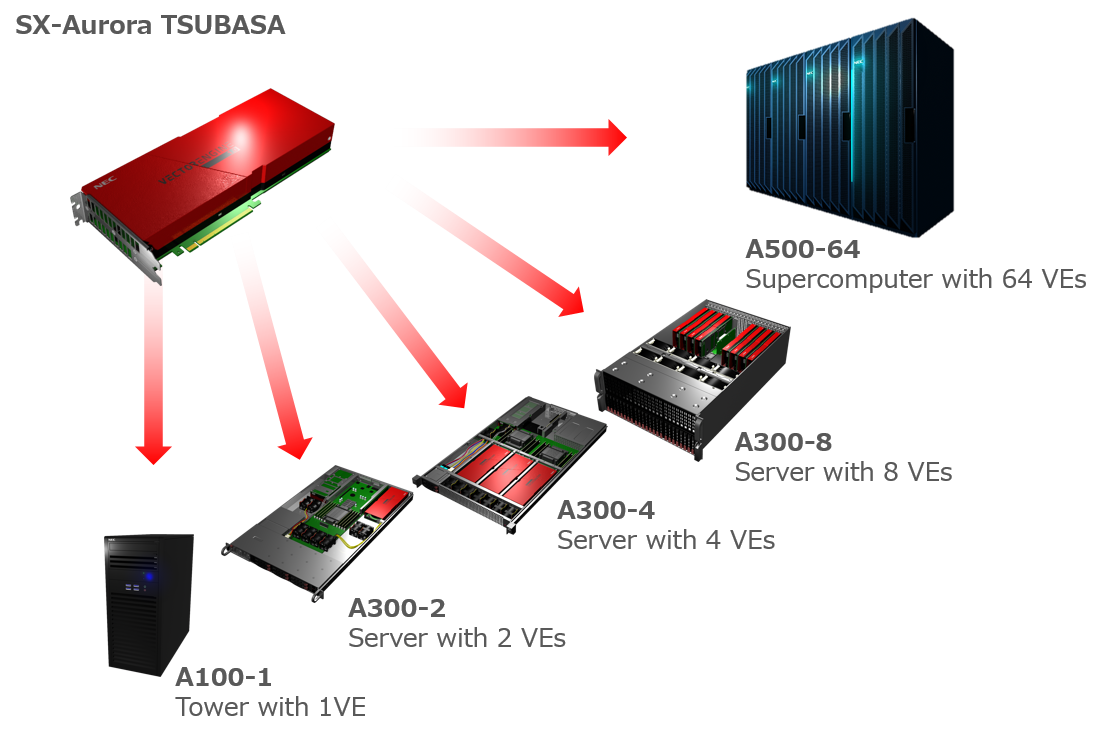
Applications - traditional, counting bitcoins, simulating nuclear explosions, learning AIDS. In general, any scientific activity. Compilers with FORTRAN, C, C ++ included.
I was also told that this is a very economical thing. On their previous
SX-ACE platform, it took 10 racks and 170 KW of power to achieve a computing power of 160 TFlops, and now one rack and 30 KW of electricity are enough.
Savings on the face.
Several booths were devoted to new products in the field of Iot (Internet of things) in the production process.
Japan, in contrast to our country, lives in production, not in resources, and in production they are in the first places in the world.
Unfortunately, this section of the exhibition was completely incomprehensible to me. Not a word in a familiar language, not a single English-speaking peasant on the stand.
In the field of production is proposed the active use of VR technology. Here, for example, they show how to use VRochki as a learning environment for a new employee in production.
Where to get the part, where and how to fasten it.
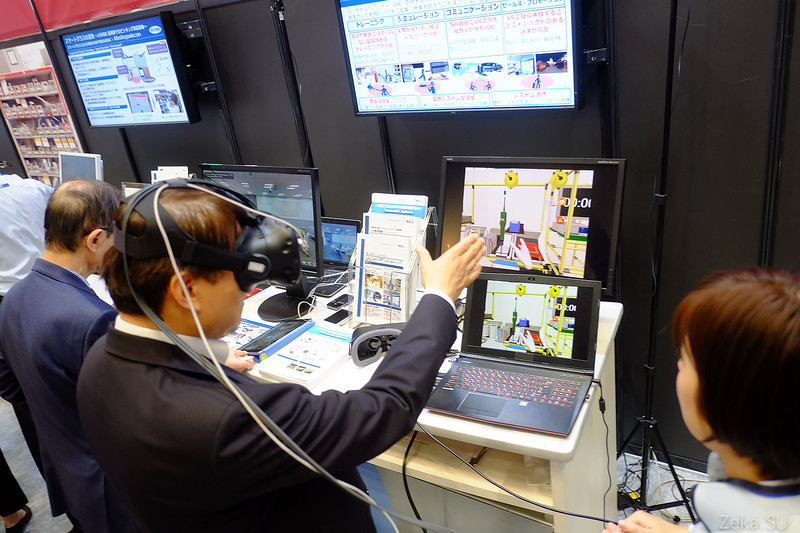
At another booth is a demonstration of the use of augmented reality glasses. For example, in warehouse activities. Points suggest where this or that product or part lies.
And this means that there is no need to teach where everything is. just follow the instructions of the assistant:

On the other stands, I did not understand anything = (
At this booth there was a demonstration of a recognition system suitable for supermarkets and manufactures. Nothing extra, camera and software.

And after a second, the picture becomes a collection of items:
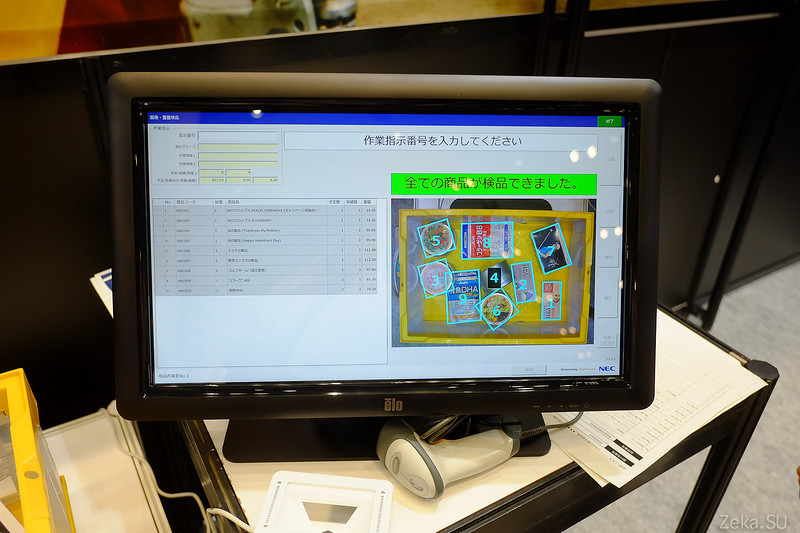
Sumermarket without sellers
Supermarket self-service. A similar decision recently launched Amazon, self-service store without a cashier
Amazon GoStore of the future:
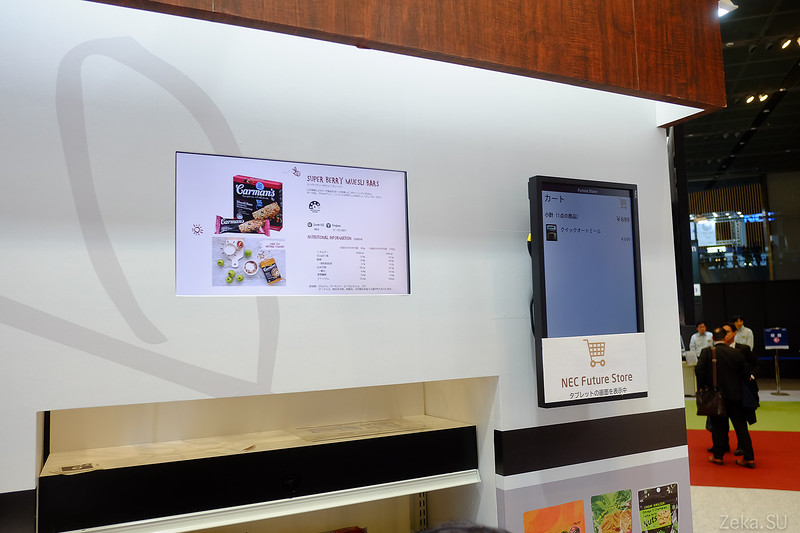
Here, as it should be with the Japanese, the complete localization of technology and everything we saw earlier about facial and object recognition is used in the shop.
How does it workFirst of all, we have to register in the system to fix our face in the system or even the iris of the eye.
Camera + ordinary tablet:
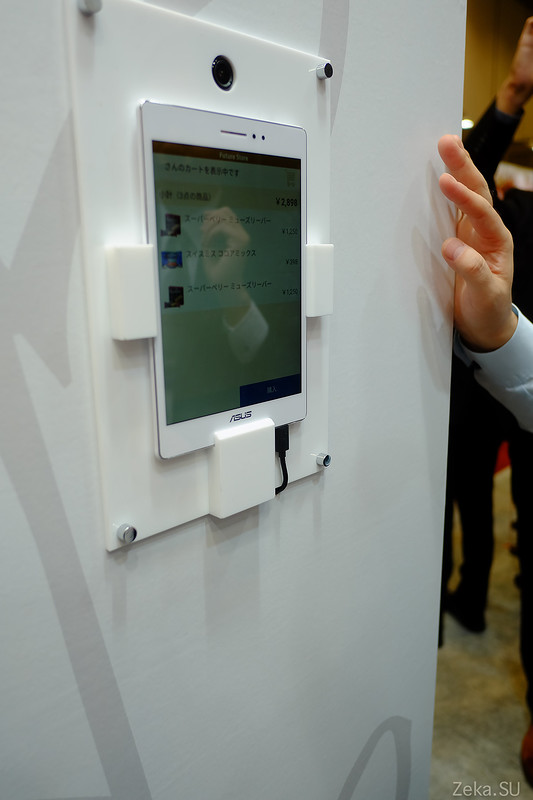
Above the shelves are cameras. You just need to take the goods from the shelf and it is automatically placed in the "basket". If the buyer returns the goods to the shelf, he is immediately deleted from the basket.
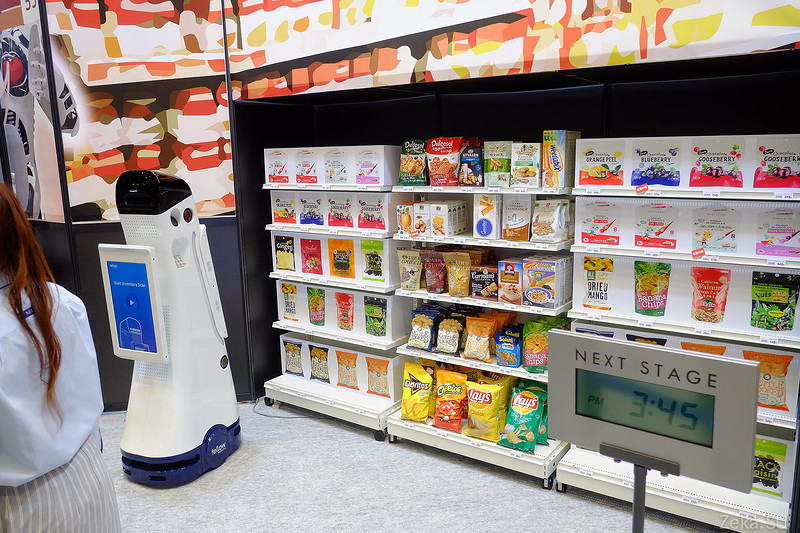
Actually that's all.
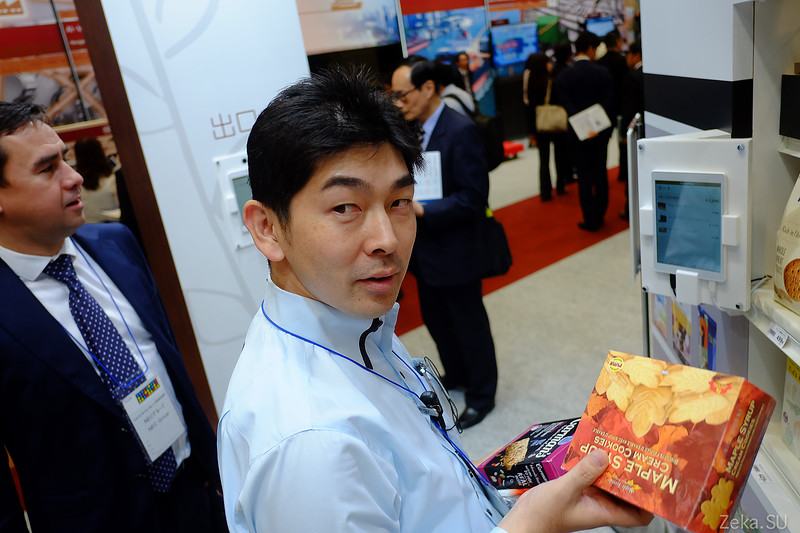
Then you just go to the terminal, the system recognizes you by the face, displays the goods you purchased and you just have to confirm payment.

Quick and convenient. When you see the system working live, this is SHOCK. The future came robots injected and not man.
The whole system works in ordinary tablets and require good cameras.
Hardware
Now the iron part of the exhibition.
NEC launches its line of blade servers:
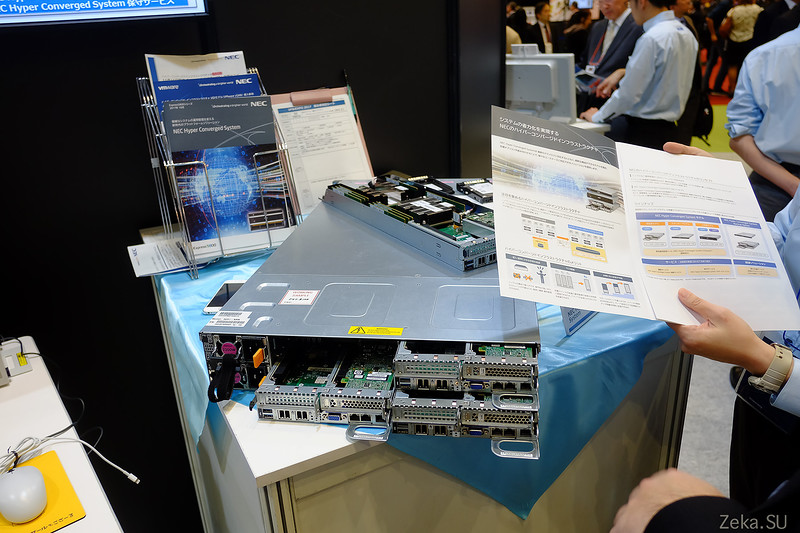
These products are more designed for the Japanese market. At their booth, there was not even a promotional paper in English. and the staff was not ready for my questions.

If you briefly tell what I understood, then this is the usual infrastructure for organizing a modern data center. NEC Hyper Converged System The product line includes servers of different capacities, SANs (storage systems) embedded in them, although there may be separate server backup switches for connecting all of this and VmWare on top of this as a hypervisor. Read more
in the brochure .
As processors naturally Xeon.
As I understand it, this is all an excellent implementation of import substitution in all sectors, what we are only talking about, works for them.
Naturally, NEC Cloud Paas / Iaas is also sold to this - a cloud service (in fact, a little doped kit from VmWare.

To all this it is worth adding that it sells not only equipment but also its full support. Installation, repair, replacement, support, warranty ... All right.
Innovation
At the exhibition there were a couple of stands with raw prototypes that are not yet sold, but they are no longer a boast. This seemed to me interesting. Here are new-fashioned wireless headphones, such as those from Apple.
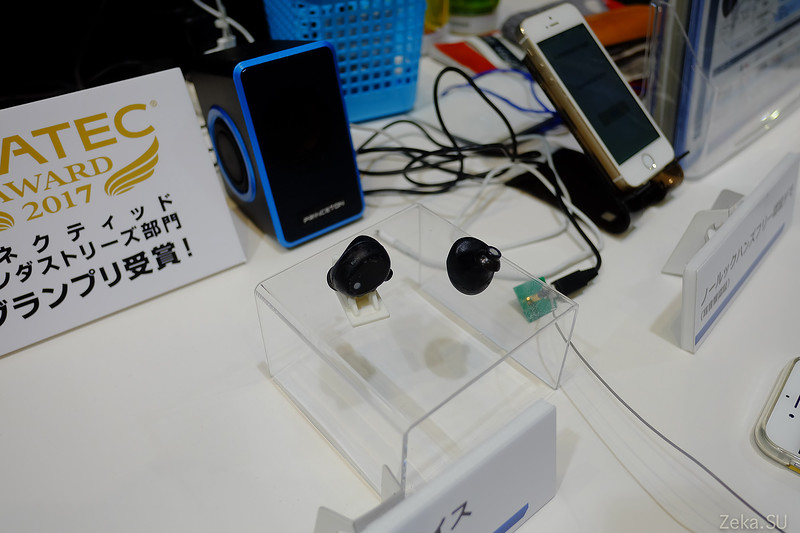
NEC Research Center is developing a biometric identification system with headphones.
As you know, the shape of the ear for each person is strictly individual. And the imprint of the auricle can be used for the same purposes as fingerprints.
They have built-in microphones that analyze the reflections of the sound in the ear and a digital impression of the ear is built using this information and you can perfectly identify the user in just 1 second of sound.

Even in these headphones installed motion sensor on 9 axes. The sensor is proposed to be used in approximately, as now fitness bracelets are used.
Measurements of user movement parameters, measurements of body temperature, pressure, pulse, voice analysis and geolocation on the ground.
As an application, the following options are offered.
Authorization and voice control, monitoring of drivers (geolocation and watch so as not to fall asleep at the wheel).
Identification of users during remote training or online testing to know exactly who is taking the test. Interestingly, the built-in compass headphone allows measurement.
And just like in the TV series "Black Mirror" voice assistant. Alas, it did not work out for me to ask more detailed information. The language barrier.
Under water and in space
Underwater FOCL (Fiber-optic communication lines). NEC is one of the leaders in the field of fiber optic links, and an amplifier was presented at the exhibition.
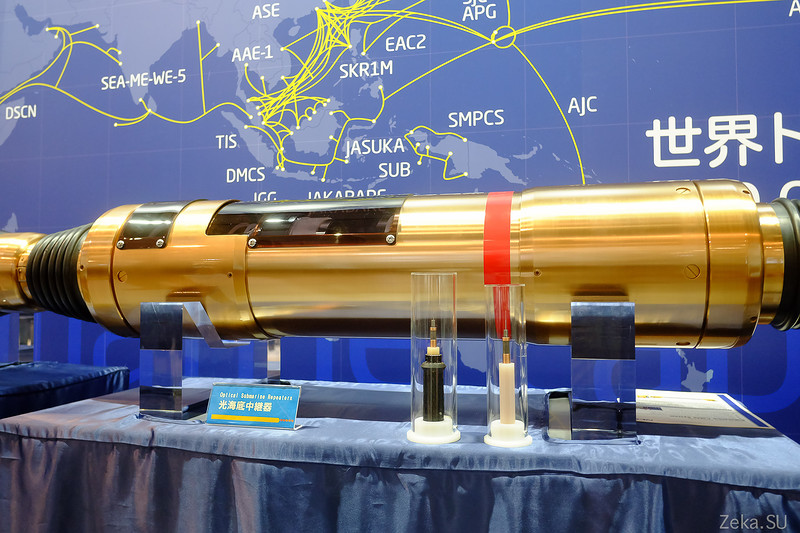
Coupling for joining.

On Giktayms there is already material about laying a fiber-optic line on Magadan - Kamchatka
https://geektimes.ru/post/279124/Here on the map are Asian communication lines. In most of them, NEC is involved.

Of the interesting, we can note 2 lines.
From Japan to Nakhodka
Rjcn
The RJCN (or Russia-Japan Cable Network) is a 640-Gbps 1800-km submarine cable system. RJCN was ready for service on September 5, 2008. By interconnecting with the Transit Europe, it can offer the shortest latency (approximately 196 ms) between Tokyo and London. And 10 Gbps transparent wavelength is available on the RJCN and TEA route.
And from Hokkaido to Nevelsk
HSCS
TransTeleCom Company CJSC (TTK), Russia's leading telecommunications backbone operator and NTT Communications Corporation (NTT Com), jointly announced today that it is a cable connection between the Nevelsk and the United States. , Sakhalin in Russia and Ishikari, Hokkaido, Japan. began commercial operation on July 3, 2008.
HSCS measures 570 Gbps. Its startup gives the driver, compared with his current 55,000 km distance.
So NEC amplifiers allow you to organize communication at a depth of 8 km. The amplifier can be placed every 100 km.

NEC is also involved in space programs. Hayabusa-2 spacecraft, manufactured by NEC Toshiba Space Systems. Launched to the asteroid 1999 JU3. In order to take samples of the soil and bring it to research on the ground.
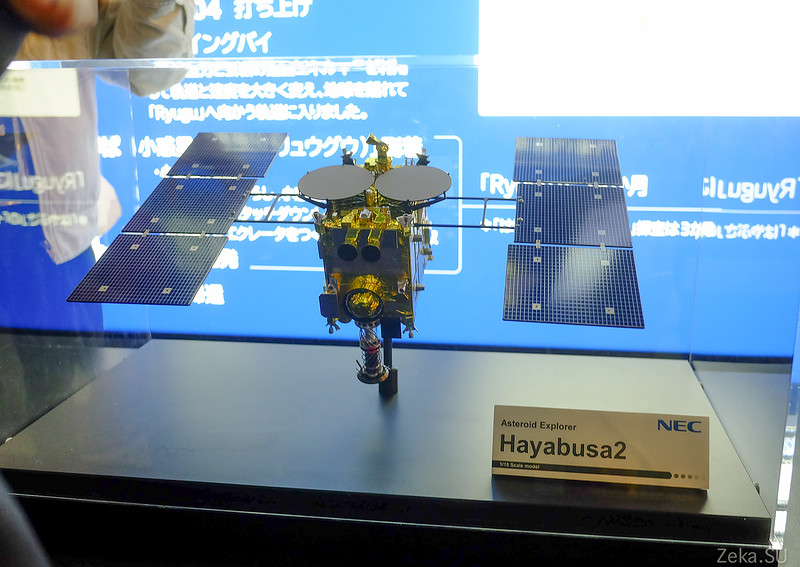
The Hayabusa-2 station launched in 2014 is designed to deliver soil samples from the asteroid (162173) 1999 JU3, also known as Ryugu. This is a dark carbon object (class C asteroid) with an elongated orbit that intersects not only the orbit of the Earth, but also Mars. It is believed that class C asteroids are most common in the solar system, and therefore they are of interest to researchers.
The rapprochement of "Hayabusy-2" with Ryugu is scheduled for July 2018. From this point on, the active phase of research will begin, which will last a year and a half. During this time, the MASCOT module on which the spectrometer, magnetometer, radiometer and camera are installed, as well as the Small Carry-on Impactor (SCI) charge consisting of a copper projectile and explosive charge to form an impact core, will be lowered. It is assumed that when approaching Ryuga, the apparatus will shoot this charge on the surface. At the bottom of the crater formed, scientists plan to detect other rock samples.
On February 26, Hayabusa-2 took a photo of Ryugu. Images were taken with the ONC-T navigation camera (Optical Navigation Camera) from a distance of 1.3 million kilometers. “Now that we have seen Ryugu, the Hayabusa-2 project has reached the final stage of preparation for arrival. There are no problems with moving to Ryugu or with the operation of a spacecraft, and we will move with maximum burden, ”notes project manager Yuichi Tsuda.
prüff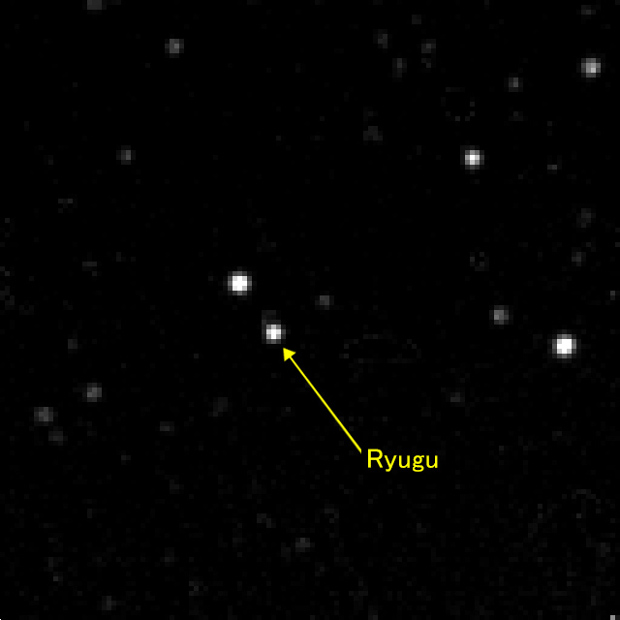
Another sample of NEC’s space products is the ASNARO 2 satellite for remote sensing of the earth.

The satellite should be launched just on the dates of the exhibition, but during testing, problems were found in Epsilon launch vehicle and the launch was postponed to January 2018.

As a result, it was launched on January 17, 2018. Intended for sounding the ground with X-band radar with resolutions up to 1 meter.
Details can be read here in
English or here in
Russian . Surprisingly, Wikipedia is still empty = (
And now the strangest thing in this exhibition. Robots, surveillance systems, recognition, server and COFFEE.
Nomeru bunkoHow I was able to explain this beauty in the NEC, conducted a study among coffee lovers.

They interviewed many people about their literary and coffee preferences.
Who loves aroma, strength, saturation and so on. On the basis of these data, a package was made of 6 variants of coffee of different taste and saturation. And knowing which books of Japanese authors you like you choose your taste.

Read more here
https://jpn.nec.com/ai/coffee/ .
I don't drink coffee, so I just took a couple of packages for souvenirs. Moreover, they are in convenient drip packages. (Rto does not know, this is a coffee that can be brewed as a tea in a mug with boiling water)
I hope you enjoyed it as best I could - I told you so.
For a trip to the exhibition thanks to the companies Rostelecom and NEC